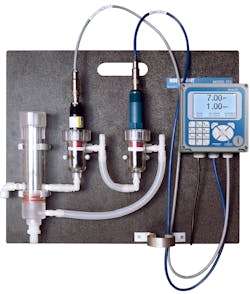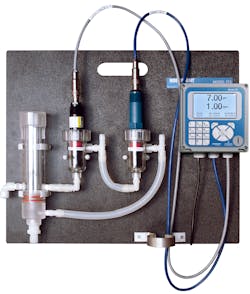Integrated Systems Approach to Free Chlorine Measurement
By Michael Francis
Water plant professionals know that there are many decisions to be made in chlorine management and one of the most important is how to measure free chlorine using the technologies available, the most prominent being colorimetric and amperometric sensors. The argument centers on whether to use a reagent-based method with its need for the continuous resupply of costly chemicals, or to use a reagent-free method and deal with the inherent pH dependence problem. Most water treatment plants have made this decision for themselves, at least temporarily, but few are completely content with their choices.
The Nature of Chlorine
Regardless of the chlorine source — chlorine gas or sodium hypochlorite — free chlorine exists as an equilibrium between hypochlorous acid and hypochlorite ion as shown in the following equation:
HOCl = H + + OCl-
This is significant because any solution of chlorine gas or bleach in the water is a mixture of hypochlorous acid and hypochlorite ions. The relative amount of hypochlorous acid or hypochlorite present depends on pH values and, to a slight extent, on temperature.
The reactivity of chlorine and its complex chemistry in an aqueous solution make the measurement of chlorine difficult. Even under ideal laboratory conditions, results vary with the method used, and process instruments can further complicate the situation. Calibration, drift, reliability and maintenance become important issues.
Two types of process monitors are generally used to measure free chlorine in drinking water systems: colorimetric or amperometric.
Colorimetric Free Chlorine Measurement
In the colorimetric method, chemicals added to the sample react with chlorine to produce a color. The darkness of the color is proportional to the amount of chlorine in the sample. The process instrument measures the color and converts the result into a parts per million (ppm) chlorine reading.
While many water authorities have used the colorimetric method, the technology has a number of drawbacks. One is reagent consumption. Reagents typically last for 30 to 60 days. On estimate, reagents for a single system can cost between $750 and $1,000 per year. Since most water authorities have hundreds of water supply systems, annual reagent costs can reach hundreds of thousands of dollars.
However, the big cost of a reagent-based system is not in materials alone but also in the manpower required to change, order, store and track them. Many of the water authority systems are far from main roads so the amount of travel time required is significant. In addition, the colorimetric analyzers have a sample conditioning system (a pump to inject reagents, tubing to carry them, and a mixing device). These parts require regular monthly maintenance, which includes cleaning, inspecting and replacing tubing, as well as calibrating and verifying the system.
Another hidden but considerable cost associated with colorimetric analyzers occurs when the reagent runs out. The residual chlorine can drift below the regulated level and the system can be put into alarm mode. Such incidents can cause the telemetry system to classify the plant as out of compliance with local and federal requirements, leading to potential fines and penalties.
Amperometric Free Chlorine Measurement
Amperometric chlorine sensors are electrochemical devices. A voltage applied to a metal electrode called the cathode causes an electrochemical reaction in which HOCl molecules combine with electrons and are destroyed (see Fig. 1). Because the concentration of HOCl at the cathode is zero, HOCl in the bulk solution diffuses to the cathode, where it too is destroyed. The continuous destruction of HOCl requires a constant flow of electrons. Thus, the sensor produces a current directly proportional to the diffusion rate. The diffusion rate, in turn, is proportional to the concentration. It is important to understand that the sensor current arises from the reaction of HOCl, not OCl-, at the cathode.
Additionally, pH changes can have a profound effect on the sensor current. Between pH 7.0 and 8.5, the typical range for drinking water, the percentage of free chlorine present as HOCl drops from 75 percent to 10 percent. Thus, the current would be expected to drop by a factor of 7.5. However, the actual drop in current is less. The current is higher than expected because of the dynamic equilibrium between HOCl and OCl-. Loss of HOCl at the cathode upsets the equilibrium, causing OCl- to form HOCl. The additional HOCl then reacts at the cathode, increasing the current. Nevertheless, the current is still a strong function of pH.
Amperometric technology has many inherent benefits. For example, the sensors are relatively free from interference. Manganese, iron, nitrate, and chromate — substances that interfere with other methods — have little influence on amperometric sensors. The sensors are low maintenance, although they do require periodic cleaning to wash away solids that slowly accumulate on the membrane. Because the technology does not need reagents, amperometric systems do not require the purchase of costly consumables or ongoing maintenance of the reagents, and these systems reduce errors due to depletion of reagents. The one significant issue is the need for pH measurement and compensation.
Dealing with pH in Amperometric Systems
Although free chlorine is a mixture of HOCl and OCl-, the current generated by an amperometric free chlorine sensor depends primarily on the concentration of HOCl in the sample. This means that if the pH of the sample changes from the value it had when the sensor was calibrated, the chlorine reading will be in error. The errors can be quite large, as much as 20 or 30 percent per unit change in pH. Because the ratio of HOCl decreases as pH increases, the increase in pH causes the current (and the apparent chlorine concentration) to drop.
One way to handle pH dependence is to treat the sample with an acid, typically vinegar, to lower the pH below approximately 5.5, where free chlorine exists only as HOCl. This is an accepted technique and is used by many manufacturers. The drawback, of course, is the need for chemical pretreatment of the sample. Using this solution for pH dependence largely eliminates the primary benefit of using a reagent-free amperometric sensor.
Amperometric analyzers can be made reagent-free by using an auxiliary pH sensor that measures the sample pH. The analyzer uses the pH measurement to correct the raw chlorine signal for changes caused by pH. The disadvantages are that the user may have to purchase and implement an additional pH measurement system to accompany the amperometric device. In addition, these systems often require a large flow sample, overusing water and representing a large ongoing cost.
An Integrated Technology Approach
Water treatment plants are addressing these issues by using an Environmental Protection Agency 334.0-compliant, fully integrated technology approach, which allows plants to meet the measurement requirement without significant compromise.
In this approach, a chlorine sensor is coordinated with a pH sensor, with both communicating to a single analyzer in an integrated system. In an effective integrated system, the pH adjustments are made automatically in the system. This type of a solution eliminates the need to purchase and incorporate two separate systems. In addition, it’s important that the system include a flow column in order to control flow rates, enable off-gassing, and reduce water consumption.
A review of relative costs between a colorimetric system and an integrated amperometric technology reveals that the initial integrated system cost would be higher. However, when considering the ongoing costs of reagents, the total operating costs are reduced by 17 percent, and labor requirements by 90 percent, over a three-year period.
A more significant advantage can be gained when the water savings are considered. At an industry standard flow rate of 7.9 gallons per hour (GPH), conventional chlorine systems use almost 208,000 gallons in three years, but an integrated amperometric system with the flow column at 3.0 GPH uses approximately 79,000 gallons — a dramatic savings of 128,772 gallons (see Table 1).
It is also significant to note that water from chemical systems contains reagents that require additional treatment for removal. In this way, the integrated amperometric solution provides cost savings as well as environmental advantages.
Amperometric technology has such obvious advantages for water plants that it’s worth examining efficient ways to make the technology work for free chlorine measurement. An integrated systems approach is one such solution. WW
About the Author: Michael Francis is global product manager at Emerson. Learn more at www.emerson.com/RosemountFCL.
About the Author
Michael Francis
Michael Francis is global product manager at Emerson. Learn more at www.emerson.com/RosemountFCL.



